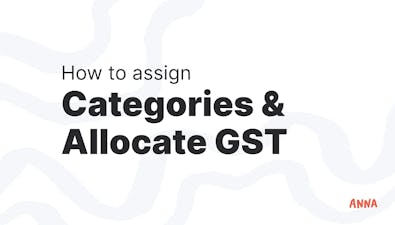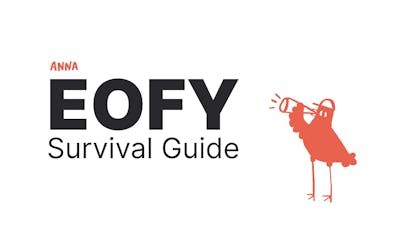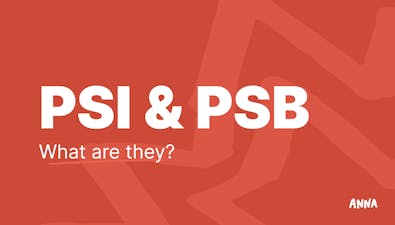
How to Switch Business Bank Accounts in Australia? [In 7 Easy Steps]


Learn how to switch business bank accounts in Australia, including key steps, considerations, and tips to ensure a smooth transition.
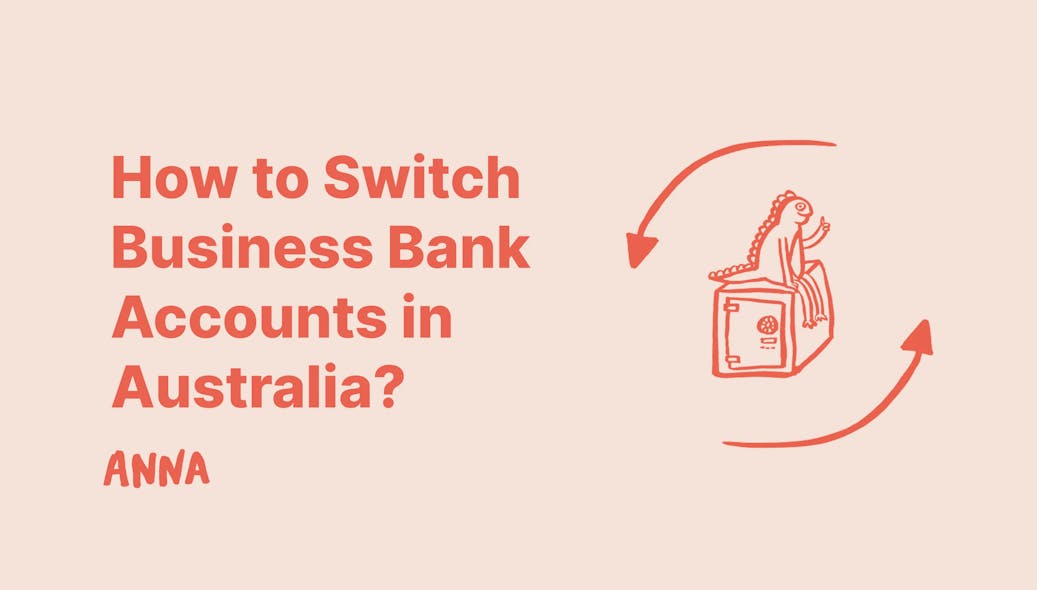
If your current bank isn't working for you, it's too pricey, too slow, or simply not good enough, it may be time to switch.
This guide will help you go through the process of switching business accounts in Australia step by step.
Plus, we'll show you how tools like ANNA Money can help you remain organised, save time, and make things easier, regardless of which bank you use.
Let's start and learn how to simplify your business banking!
Which Banks Are Considered the Best in Australia?
Since you are wondering how to switch business bank accounts in Australia, let’s first check the best options.
The Big Four – Commonwealth Bank, Westpac, NAB, and ANZ – are often regarded as Australia's best banks due to their size, stability, and extensive service offerings:
🟧 Commonwealth Bank of Australia (CommBank) - It is Australia's largest bank in terms of assets and market capitalisation, with a significant branch and ATM network as well as strong internet banking capabilities.
🟧 Westpac Banking Corporation (Westpac) - As Australia's oldest bank, it provides a diverse variety of commercial and retail services, backed by a strong national footprint.
🟧 National Australia Bank (NAB) - With a primary focus on business banking, it provides a diverse range of financial products and strong support for small and medium-sized businesses (SMEs).
🟧 Australia & New Zealand Banking Group (ANZ) - With a vast international base, it offers comprehensive commercial and retail banking services and is set for additional expansion following the acquisition of Suncorp Bank.
While the Big Four dominate around 70% of the Australian banking market, several other banks are highly respected for specific needs or customer-owned banking:
🟨 Macquarie Bank - Well-known for its investment and business banking services, as well as cheap home lending offerings.
🟨 Bendigo & Adelaide Bank - Known for its community banking and excellent customer service.
🟨 Bank of Queensland - Focuses on personal and business banking, particularly in Queensland.
🟨 Heritage Bank - A customer-owned bank that is well-known for providing personalised service and offering competitive business accounts.
🟨 Suncorp Bank - Strong in Queensland, offering a comprehensive range of commercial and personal banking services.
7 Steps To Switch Business Bank Accounts in Australia
Follow these steps to successfully switch business bank accounts:
Step 1: Assess Your Business Banking Needs
Before making any decisions, consider how your present business bank account is performing for you – and, more importantly, where it falls short.
Are you paying too many monthly fees?
Is the online banking software difficult to use or out of date?
Are you faced with transaction fees that do not fit with your business model?
Then, make a list of the features that are important to your business.
These may include:
✔️ Low or transparent fees - Monthly account charges, transaction prices, and ATM fees.
✔️ Reliable customer service - Especially important if something goes wrong or you need immediate assistance.
✔️ Access to business loans or overdraft features - Beneficial for cash flow and growth demands.
✔️ Payment flexibility - Options include quick BPAY, PayID, and batch payments for payroll.
Also, consider the stage and scale of your business.
If you are a sole trader, then you may require something different from a growing business with many workers and suppliers.
The more specific you are about your requirements, the easier it will be to choose the appropriate account when reviewing options.
Step 2: Research and Choose a New Bank
Once you've determined what you need, it's time to look into your possibilities. Not all business accounts are made equal, and the best option will be heavily influenced by the size of your business,the business's nature, and daily financial management.
Begin by comparing different banks and credit unions and look for these things:
✔️ Account fees and transaction limits – Check for free transactions, deposit limits, or hidden fees.
✔️ Quality of online banking and mobile apps - Vital for managing your accounts while on the road.
✔️ Reputation and reviews - For firsthand information, consult online reviews and business forums.
✔️ Business features and integrations - Some banks have built-in invoicing, budgeting tools, and direct links to accounting software.
💡ProTip
If you are looking for accounting software that you can connect to your account, look no further than ANNA Money!
With our invoicing software, you can:
- Connect business and personal accounts and thus have a clear overview of your finances from one place
- Schedule every repeated payment
- Get notification whenever you make a payment or receive one
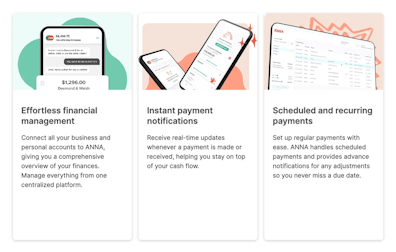
Step 3: Open Your New Business Bank Account
Once you've decided on a bank, the next step is to open a new business account.
Most Australian banks allow you to apply online or in-branch, depending on what works best for you and the complexity of your business structure.
Before you begin the application, ensure that you have all of the relevant paperwork.
Banks are legally required to verify your name and business information, so being prepared can save a lot of effort and time.
Here's what you'll usually need:
✔️ Business information - Includes your ABN (Australian Business Number), registered business name, trading address, and contact information.
✔️ Entity documentation - It will differ depending on your business structure:
- Sole traders must register for an ABN and provide identification.
- For partnerships, a partnership agreement and partner information.
- Companies must get a certificate of incorporation and register with ASIC.
✔️ Personal ID - In most cases, all company directors, owners, or authorized signatories must provide proper government-issued identification, such as a driver's license or passport.
Some banks may additionally inquire about your anticipated transaction volume or how you intend to use the account, particularly if you're seeking additional services such as an overdraft or merchant terminal.
If everything is in order, your account could be up and running in a day or two – or perhaps instantly for simpler setups.
When it opens, you'll be able to begin transferring funds.
Step 4: Make a List of All Automatic Payments and Deposits
Before cancelling your previous account, you should keep note of all automatic payments and deposits that are currently tied to it. This guarantees a smooth transition and prevents missing payments or lost money.
Go through at least 12 months of bank statements – some seasonal or annual payments may not appear in a shorter time frame.
Make a clear list of everything related to your account, including:
✔️ Automatic deposits:
- Customer payments (particularly recurring ones through direct debit)
- Government benefits or rebates (e.g., BAS credits, ATO refunds)
- Payouts from platforms including PayPal, Stripe, Afterpay, and eBay
- Rental revenue or affiliate commissions
✔️ Automatic debits:
- Utility bills
- Office rental or leasing costs
- Software subscriptions (such as Xero, Microsoft 365, and Shopify)
- Payroll or Superannuation payments
- Loan or credit card payments
✔️ Linked accounts and transfers:
- Transfers into corporate savings accounts
- Business credit cards
- Partner or director drawings
Step 5: Notify Customers, Suppliers, and Service Providers
Once your new business account is functioning, it's time to notify everyone who regularly sends or receives payments from your company.
This ensures that your cash flow remains uninterrupted throughout the period of transition.
Begin by informing your clients, suppliers, and service providers of your new bank information well in advance – at least a couple of weeks before the transfer.
This allows them time to change their records and avoid lost payments or delays.
Also, check any payment portals or e-commerce platforms you use to ensure that the new details are reflected there, especially for online transactions.
Step 6: Move Funds to the New Account
Now that your new business account is active and all of your payment information has been changed, it's time to transfer your funds.
Here's how to do it successfully:
✔️ Start by transferring a portion of your funds - This allows you to start utilising your new account for daily transactions while keeping the old account open to handle any outstanding payments or difficulties that may occur.
✔️ Monitor your old account - Keep an eye for 2-4 weeks after the transfer. This will allow you to catch any pending transactions, such as cheques that have not yet cleared or automatic debits that are still coming through. Leave enough funds in the old account to cover these payments while progressively transferring more of your business funds to the new account.
✔️ Gradually move the remaining balance - After confirming that all payments and automatic transactions have been successfully processed from the new account, gradually transfer the remaining money from the old to the new account.
✔️ Create a contingency plan - During the transfer, keep track of any payment deadlines or regular transactions associated with your old account. This will avoid any accidental missing payments during the procedure.
Step 7: Close the Old Bank Account
Once you've transferred all of your funds and changed your payment information, it's time to cancel the old bank account. This final step verifies that there are no outstanding concerns and that your organisation has fully moved to the new account.
Take these steps:
✔️ Double-check all transactions - Before terminating your old account, double-check all pending transactions. Ensure that all deposits, payments, and automatic transactions (such as subscriptions or salary payments) are fully transferred to the new account. It is critical that there are no outstanding cheques or missing payments.
✔️ Confirm with your bank - After confirming the move, contact your bank to cancel the account. Some banks may require you to visit a branch in person or make a request via online banking.
✔️ Obtain a final statement - Before closing, ask your bank for a final statement to confirm that your account is fully cleared. This statement will be a record of the account's closure and can be used for tax purposes or future reference.
Conclusion
With the correct approach and a clear understanding of your company's needs, switching can help you save money, stay organised, and operate more productively.
Whether you choose a large bank or a smaller, more personal choice, the most important thing is that your account is appropriate for your business.
Once you've made the switch, tools like ANNA Money can help make things easier.
ANNA handles the tedious tasks of sending invoices, tracking costs, and filing taxes, allowing you to focus on running your business. It's not a bank, but it works well alongside whichever one you choose.
So, if you're ready to switch, make it count – and let ANNA handle the details.
ANNA Money: Viable Alternative
ANNA Money is not a bank; it is a financial assistant and smart business tool designed for modern businesses. It keeps you in charge of your budget by allowing you to:
- Open business account
- Send and track professional invoices
- Connect and see multiple accounts (personal and business) in one spot.
- Schedule recurring payments effortlessly
- Get real-time notifications for all transactions
Here are key features:
🟩 Instant expense capturing - Raise expenditures on the move using only a photo. Snap, provide a few details, and ANNA will save all of your receipts in one secure location.
🟩 Expert tax relief advice - Our skilled accountants handle your expenses, ensuring that you receive the necessary tax reduction as soon as possible.
🟩 Automated invoice chasing - Allow ANNA to chase unpaid invoices with courteous, automated emails.
🟩 Payroll - ANNA +Taxes calculates payroll for your limited company without the need for an accountant.
🟩 Pots - Automatically set aside a percentage of your business profits to cover future tax obligations.
🟩 Corporate tax - ANNA +Taxes can help you register for Corporation Tax, determine your owing, and fulfil all dates.
🟩 Bookkeeping score - Get simple tasks to keep your books organised and tidy. The higher your score, the more tax you may save!
🟩 Invoice generator - Create and send business-specific invoices and get a unique payment link that allows clients to pay you online, via QR codes, or using the Stripe payment platform.
In other words, ANNA helps you manage your money more effectively, regardless of the bank you use.
So, if you've chosen a bank that meets your business needs, sign up for ANNA Money and add it to your financial toolkit to keep things moving smoothly!


